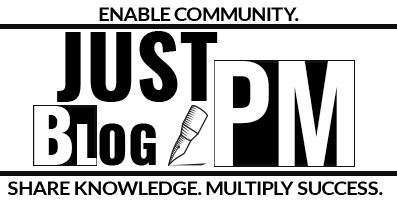

catalyze. collaborate. unleash.
- Failures and Mistakes
- Abusive Leadership
- Leadership ‘n’ Communication
- Basic Essentials
- Professional Responsibilities
- Scope Essentials
- Schedule Essentials
- Communication Essentials
- Project HR Essentials
- Project Cost Essentials
- Quality Essentials
- Risk Essentials
- Procurement Essentials
- Integration Essentials
- Project Management Battlefield
- Notes on Project Management Knowledge
Pre-assignment: Ensuring Project Success from the Start
In project management, ensuring the right resources are in place from the outset can be a critical determinant of success. One technique that stands out in this context is pre-assignment. Here’s a deeper dive into the concept and its significance.
Understanding Pre-assignment
Pre-assignment is essentially earmarking specific individuals for roles in a project even before the project kicks off. It’s about clearly defining who will be involved and in what capacity right from the planning phase.
Why Pre-assignment?
- Skill Specificity: Some projects demand highly specialized skills. If there’s a known expert within the organization who fits the bill perfectly, it makes sense to pre-assign them to ensure the project benefits from their expertise.
- Client Expectations: In competitive bidding scenarios, including certain key personnel can be a selling point. If a client has been promised the involvement of specific individuals based on their reputation or expertise, pre-assignment becomes a contractual obligation.
- Resource Optimization: Pre-assignment can be a strategic move to ensure top talent is reserved for high-priority projects, preventing them from being tied up in other, less critical assignments.
- Project Charter Documentation: Pre-assignments might be documented in the project charter as a formal record of who has been designated for specific roles. This can provide clarity and direction as the project progresses.
Benefits of Pre-assignment
- Clarity and Direction: Knowing key team members from the outset provides a roadmap for the project, allowing for more precise planning and execution.
- Boosted Morale: Being pre-assigned can boost individuals’ morale, signaling trust in their abilities and recognizing their value to the organization.
- Streamlined Onboarding: With pre-assignment, the onboarding process can be more efficient. Since roles and responsibilities are defined early on, there’s less ambiguity and a smoother transition into the project phase.
- Client Satisfaction: Meeting client expectations by ensuring promised personnel are involved can enhance client satisfaction and trust.
In Conclusion:
Pre-assignment is more than just a logistical move; it’s a strategic decision that can set the tone for a project’s trajectory. By ensuring the right people are in place from the get-go, project managers can pave the way for smoother execution, optimal resource utilization, and enhanced outcomes.
Share This Story, Choose Your Platform!
Related posts, a synopsis of team management in project leadership, strategies and best practices for effective conflict resolution in project management, conflict resolution in project management, effective decision making in project management.

Pre-order your copy with Exclusive Launch offer
Pre-assignment
- Edit source
- View history
Pre-assignment of project team members can occur for a few reasons. Sometimes specific people are identified in an agreement with a customer or partner. Another reason for pre-assignment is to plan human resource management for the future or over multiple projects or activities. This is most likely when someone has skills or knowledge that are rare or in high demand. Some organization require pre-assignment as a way of determining whether it will be necessary to hire or contract for additional staff or to delay the project until the right staff will be available.
Pre-assignment is a potential technique used in the PMI process to acquire project teams .
Section 9.2 Acquire Project Team
Acquire Project Team is the process of obtaining the human resources needed to complete the project. The project management team may or may not have control over team members selected for the project.
Section 9.2.1 Acquire Project Team: Inputs
.1 Enterprise Environmental Factors
Project team members are drawn from all available sources, both internal and external. When the project management team is able to influence or direct staff assignments, characteristics to consider include:
Availability. Who is available and when are they available?
Ability. What competencies do people possess?
Experience. Have the people done similar or related work? Have they done it well?
Interests. Are the people interested in working on this project?
Cost. How much will each team member be paid, particularly if they are contracted from outside the organization?
.2 Organizational Process Assets
One or more of the organizations involved in the project may have policies, guidelines, or procedures governing staff assignments ( Section 4.1.1.4 ). The human resource departments also can assist with recruitment, hiring and orientation of project team members.
.3 Roles and Responsibilities
Roles and responsibilities define the positions, skills, and competencies that the project demands ( Section 9.1.3.1 ).
.4 Project Organization Charts
Project organization charts provide an overview regarding the number of people needed for the project ( Section 9.1.3.2 ).
.5 Staffing Management Plan
The staffing management plan, along with the project schedule, identifies the time periods each project team member will be needed and other information important to acquiring the project team ( Section 9.1.3.3 ).
Section 9.2.2 Acquire Project Team: Tools and Techniques
.1 Pre-Assignment
In some cases, project team members are known in advance; that is, they are preassigned. This situation can occur if the project is the result of specific people being promised as part of a competitive proposal, if the project is dependent on the expertise of particular persons, or if some staff assignments are defined within the project charter.
.2 Negotiation
Staff assignments are negotiated on many projects. For example, the project management team may need to negotiate with:
Functional managers to ensure that the project receives appropriately competent staff in the required time frame, and that project team members will be able to work on the project until their responsibilities are completed
Other project management teams within the performing organization to appropriately assign scarce or specialized resources.
The project management team's ability to influence others plays an important role in negotiating staff assignments, as do the politics of the organizations involved ( Section 2.3.3 ). For example, a functional manager will weigh the benefits and visibility of competing projects when determining where to assign exceptional performers that all project teams desire.
.3 Acquisition
When the performing organization lacks the in-house staff needed to complete the project, the required services can be acquired from outside sources ( Section 12.4.3.1 ). This can involve hiring individual consultants or subcontracting work to another organization.
.4 Virtual Teams
The use of virtual teams creates new possibilities when acquiring project team members. Virtual teams can be defined as groups of people with a shared goal, who fulfill their roles with little or no time spent meeting face to face. The availability of electronic communication, such as e-mail and video conferencing, has made such teams feasible. The virtual team format makes it possible to:
Form teams of people from the same company who live in widespread geographic areas
Add special expertise to a project team, even though the expert is not in the same geographic area
Incorporate employees who work from home offices
Form teams of people who work different shifts or hours
Include people with mobility handicaps
Move forward with projects that would have been ignored due to travel expenses.
Communications Planning ( Section 10.1 ) becomes increasingly important in a virtual team environment. Additional time may be needed to set clear expectations, develop protocols for confronting conflict, include people in decision-making, and share credit in successes.
Section 9.2.3 Acquire Project Team: Outputs
.1 Project Staff Assignments
The project is staffed when appropriate people have been assigned to work on it. Documentation can include a project team directory, memos to team members, and names inserted into other parts of the project management plan, such as project organization charts and schedules.
.2 Resource Availability
Resource availability documents the time periods each project team member can work on the project. Creating a reliable final schedule ( Section 6.5.3.1 ) depends on having a good understanding of each person's schedule conflicts, including vacation time and commitments to other projects.
.3 Staffing Management Plan (Updates)
As specific people fill the project roles and responsibilities, changes in the staffing management plan ( Section 9.1.3.3 ) may be needed because people seldom fit the exact staffing requirements that are planned. Other reasons for changing the staffing management plan include promotions, retirements, illnesses, performance issues, and changing workloads.

Excel in Project Management
PRE-ASSIGNMENT – PMP Tools and Techniques

Description

Where it is Used
This tool is used in the following Process Group(s) during the project management.
This tool is used in the following Knowledge Areas during project management.
Related Posts:
- SCHEDULE NETWORK ANALYSIS – PMP Tools and Techniques
- STRATEGIES FOR THREATS – PMP Tools and Techniques
- RESOURCE OPTIMIZATION – PMP Tools and Techniques
- PARAMETRIC ESTIMATING – PMP Tools and Techniques
- KNOWLEDGE MANAGEMENT – PMP Tools and Techniques
- GROUND RULES – PMP Tools and Techniques
- FUNDING LIMIT RECONCILIATION – PMP Tools and Techniques
- DEPENDENCY DETERMINATION AND INTEGRATION – PMP Tools and Techniques
- DECOMPOSITION – PMP Tools and Techniques
- CONTINGENT RESPONSE STRATEGIES – PMP Tools and Techniques
- CONTEXT DIAGRAM – PMP Tools and Techniques
- ANALOGOUS ESTIMATING – PMP Tools and Techniques
Kailash B is a project management expert. He is passionate about helping people to excel in project and product management, become PMP certified, and progress in their management careers.
Similar Posts

ACTIVE LISTENING – PMP Tools and Techniques
Description Active listening is a communication technique that requires the listener to fully engage with the speaker, and to understand, interpret, and respond to what is being said. It is an important skill in any context, but especially in project management, where effective communication is essential to successful outcomes. The PMBOK (Project Management Body of Knowledge) defines…

RISK PROBABILITY AND IMPACT ASSESSMENT – PMP Tools and Techniques
Description Risk probability assessment talks about assessing the likelihood of the risk. Risk impact assessment talks about the impact related to the finance, time, resource, scope, and performance of the project. It belongs to the tool category – Data Analysis Where it is Used Process Groups This tool is used in the following Proces Group(s) during the project…

SIMULATION – PMP Tools and Techniques
Description A technique to analyze the combined effects of project risks and other sources of uncertainties to evaluate the potential impact on the project objectives including scope, cost, time, and effort. Example – Monte Carlo Analysis. It is an independently-used project management tool. Where it is Used Process Groups This tool is used in the following Process Group(s)…

INTERVIEWS – PMP Tools and Techniques
Description Interviews It is a formal or informal method to elicit information by talking directly usually in a private environment. It belongs to the tool category – Data gathering Where it is Used Process Groups InitiatingPlanning Knowledge Areas Project Integration Mgmt.Project Quality Mgmt.Project Risk Mgmt.Project Scope Mgmt. Activities Develop Project CharterDevelop Project Management PlanPlan Quality ManagementIdentify RisksPerform Qualitative Risk AnalysisPerform Quantitative Risk…

PROBLEM SOLVING – PMP Tools and Techniques
Description It deals with the job of finding solutions to the issues and challenges by gathering information, doing critical thinking, and using quantitative & logical approaches. It is mainly used in Resource Management and Quality Management. In Resourcement Management, it is mainly a leadership skill. In Quality Management, it is the key element in Quality Assurance…

COMMUNICATION SKILLS – PMP Tools and Techniques
Description Communication Skills Where it is Used Process Groups ExecutingMonitoring & Controlling Knowledge Areas Project Communications Mgmt.Project Stakeholder Mgmt. Activities Manage CommunicationsManage Stakeholder EngagementMonitor Stakeholder Engagement Process Group Knowledge Area Activity Executing Project Communications Mgmt. Manage Communications Project Stakeholder Mgmt. Manage Stakeholder Engagement Monitoring & Controlling Project Stakeholder Mgmt. Monitor Stakeholder Engagement Kailash B, MBA, PMP®Copyrights Reserved (MyPMP) Related Posts: PRESENTATIONS –…
Leave a Reply Cancel reply
Your email address will not be published. Required fields are marked *
Save my name, email, and website in this browser for the next time I comment.
- li:not(.tcb-excluded-from-group-item)"> Home
- li:not(.tcb-excluded-from-group-item)"> About
- li:not(.tcb-excluded-from-group-item)"> Blog
- li:not(.tcb-excluded-from-group-item)"> Videos
- li:not(.tcb-excluded-from-group-item)"> Webinars
- li:not(.tcb-excluded-from-group-item)"> Calendar
- li:not(.tcb-excluded-from-group-item)"> RiskHub (U.S.)
- li:not(.tcb-excluded-from-group-item)"> PMI-RMP Courses
How to Deal With Pre-assigned Project Resources
2=Planning, Leadership, Productivity
- Minute Read
Looking for ways to improve your project success? People matter more than technology and processes. However, project managers rarely choose their teams. Let's talk about how to deal with pre-assigned project resources.

Are you working in an organization where your project resources are preassigned? Do you feel like you get the left-over resources most of the time? Are you frustrated by the demands to deliver with inadequate resources? Here are some strategies to help you obtain the resources you need.
- Negotiate. First, determine who assigns the resources? Is it a functional manager? Does your organization have a resource manager? Will a vendor or supplier provide resources? Second, meet to discuss the goals of your project and the knowledge and skills that will be required for success. Third, recommend resources for the team.
- Influence. What do we do if we work for a large organization where we do not have access to the individuals making the assignments? Someone has access to these people. Does your sponsor have access? Does your manager have the right connections. If so, influence the people you know and make your case. Ask your connections to influence the decision makers.
- Acquire outside resources. When your organization lacks staff to complete the required project activities, see if you can acquire outside resources. Here is one reason that project managers need to be involved in projects early. You can make your case and build the resource cost in your budget.
- Develop your teams. At the end of the day, you will be assigned teams. Guess what? The teams will not be perfect. What skills and competencies are lacking? Are the team members motivated? What do you need to do to improve overall project performance ? Look for ways to improve the knowledge and skills, create team building opportunities, build trust, and encourage collaboration.
Doing the Same Things, Expecting Different Results
Many organizations have under-performing projects. Why? Organizations do a poor job of defining their projects and understanding the resource requirements.
Additionally, organizations overcommit – they commit to more projects than they should. Team members are stressed and organizations experience a lot of employee turnover. Furthermore, organizations fail to identify and acquire and develop skills and knowledge for these resource bottlenecks.
I am sometimes asked to take a look at organization’s resource problems and help them find solutions. My response? Do fewer projects better. Unfortunately, most organizations fail to curb their appetites and continue doing the same things and expect different results!
You may also like
12 good reasons you are struggling with small projects, mastering the pmi-rmp exam: effective study strategies.
Session expired
Please log in again. The login page will open in a new tab. After logging in you can close it and return to this page.

1. Project Team Acquiring
The process of acquiring project team is an activity that allows selecting and approving human resource availability according to the list of required skills and criteria for choosing human resource for the purpose of obtaining the team necessary to accomplish project work.
The process is managed by the project management team. The project manager is a person who has an authority to manage the recruiting process and decide on team members. While selecting and deciding on team members, the following acquiring project team criteria should be considered:
- Required level of experience at appropriate projects and activities. The project manager gathers all information about current experience level of team member to compare it with the required experience level.
- Interest level. The project manager defines whether team member is interested in participating in project and why.
- Personal qualifications. By means of interviews and questionnaires, the project manager look at personal skills and talents of team member and measure how this individual team member will work with other project team members.
- Availability. The project manager identifies whether project team member desired for the project is available. The project manager should decide with functional managers on the availability of potential team members.
- Knowledge. The project manager identifies the competency and proficiency of available project team members.
By using the acquiring project team criteria, the project manager and members of the project management team select a method of team acquisition. There are several standard acquiring project team methods , including the following:
- Method of pre-assignments allows selecting team members in advanced, before project starts. The method is used in situations when implementation of project depends on the expertise of specific people who deliver a competitive proposal to project.
- Method of virtual team building is used when the whole project or a significant part of it is to be fulfilled by groups of people who carry out their roles and responsibilities with little or no time spent on face to face communication and collaboration. Virtual teams use electronic means of communication (such as email and video conferencing) to fulfill project tasks. A virtual team environment is based on communication planning so the project manager needs to ensure virtual teams have all required communication tools to participate in project.
- Method of negotiations allows making staff assignments between multiple projects in order to ensure each of the projects has appropriately competent human resources within the required time frame. The method entails development and use of delegation and re-assignment models to make efficient staff assignments considering the benefits and visibility of competing projects.
The team acquisition methods can be used separately or taken together to acquire project team. Project gets staffed when all team members have appropriate assignments. Then the process of acquiring project team comes to an end and generates the following acquiring project team outputs:
- Project staff assignment documentation – includes names of project team members, memos to team members, and a project team directory.
- Work schedules – document team member availability and include time periods that every team member can work on project considering schedule conflicts, such as vacation time and commitments to other projects.
- Updates to the project management plan – concern such elements of the plan as human resource plan and staffing requirements.
Jump to the nest step of the human resource management process:
- Project Team Acquiring
- Project Team Developing
- Project Team Managing
Worth Reading

Partnering with a Project Management Consultancy is Worth a Try
May 30, 2013

Seismic Shift in Human Resources Functionality
March 21, 2014

Project Life-Cycle Template – Key Phases of the Generic Model
November 17, 2011

5 Productivity Tips for Already Busy People
May 22, 2015

Marketing Lessons from the Online Casino Industry
April 17, 2021

Career & Lifestyle
Project Management: The Future and Reasons to Study

Nature-Based Retreats for Leadership Reflection

Project initiation stage – Project Initiation Document (PID). Duties of project owner and project team

Organizing Procurement and Purchasing Activities in a Project

Two Common Mistakes in Project Procurement Contracts

Project Sponsor – The Role and Responsibilities
Acquire Project Team
Acquire Project Team is the process of confirming human resource availability and obtaining the team necessary to complete project assignments. See Figures 9-7 and 9-8. The project management team may or may not have direct control over team member selection because of collective bargaining agreements, use of subcontractor personnel, matrix project environment, internal or external reporting relationships, or other various reasons. It is important that the following factors are considered during the process of acquiring the project team:
• The project manager or project management team should effectively negotiate and influence others who are in a position to provide the required human resources for the project.
• Failure to acquire the necessary human resources for the project may affect project schedules , budgets, customer satisfaction, quality, and risks. It could decrease the probability of success and ultimately result in project cancellation.
• If the human resources are not available due to constraints, economic factors, or previous assignments to other projects, the project manager or project team may be required to assign alternative resources, perhaps with lower competencies, provided there is no violation of legal, regulatory, mandatory, or other specific criteria.
These factors should be considered and planned for in the planning stages of the project. The project manager or project management team will be required to reflect the impact of any unavailability of required human resources in the project schedule, project budget, project risks, project quality, training plans, and the other project management plans as required.
.1 Project management plan .2 Enterprise environmental factors .3 Organizational process assets
.1 Pre-assignment .2 Negotiation .3 Acquisition .4 Virtual teams
.1 Project staff assignments .2 Resource calendars .3 Project management plan updates
Figure 9-7. Acquire Project Team: Inputs, Tools & Techniques, and Outputs

Continue reading here: Team Building Activities
Was this article helpful?
Recommended Programs

PM Milestone Business Templates

Accidental Project Manager

Project Report Progess Status Templates
Related Posts
- Perform Quality Control - Strategic Planning
- Outputs of Acquire Project Team
- Three types of dependencies are used to define the sequence among the activities
- Phaseto Phase Relationships
- Schedule Compression - Strategic Planning
Readers' Questions
How to acquire project team as a project manager?
Create a list of the necessary skills and positions. Identify the roles and tasks that need to be completed for the project and determine which positions are required to complete them. Develop a recruitment plan. Create a job profile for each position your project requires, including qualifications and desired experience. Decide on a timeline for recruitment and the best ways to advertise openings. Source potential team members. Consider existing contacts, your existing team, and outside sources such as job boards, recruitment agencies, and social networks. Interview candidates. Use the job profile you created to structure your interviews and develop a set of questions to ask each candidate. Choose team members. Evaluate each candidate and make an informed decision on who to hire. Onboard the chosen team members. Make sure each team member understands their role, the project’s expectations, and any deadlines. Monitor team progress. Monitor each team member’s progress and ensure the project is staying on track.
- Project planning |
- Project initiation: The first step to s ...
Project initiation: The first step to successful project management

Project initiation ensures that you lay a strong foundation for a new project. It’s the first of five project management phases, when you outline why you’re doing the project and what business value it will deliver. Then, you can use that information to secure buy-in from key stakeholders. In this article, we describe why project initiation matters and outline four key steps to start your project off on the right foot.
“Let’s start at the very beginning, a very good place to start.”
What is project initiation?
Project initiation is the first step in starting a new project. During the project initiation phase, you establish why you’re doing the project and what business value it will deliver—then use that information to secure buy-in from key stakeholders.
The term “project initiation” comes from a five-phase model created by the Project Management Institute (PMI). PMI outlines this model in their Guide to the Project Management Body of Knowledge, also known as the PMBOK® Guide . The model divides a project’s lifecycle into these five stages:
Project initiation : Broadly define your project and secure buy-in.
Project planning : Create detailed goals and a project roadmap.
Project execution : Launch your project using information from the first two steps.
Project performance : Measure effectiveness using key performance indicators (KPIs) .
Project closure : Debrief with stakeholders.
Project initiation vs. project planning
During the project initiation phase, you define your project at a high level in order to demonstrate its business value. Once you secure buy-in from key stakeholders and prove that your project is feasible, you then move on to the project planning phase. That’s when you define your specific objectives , deliverables , and project roadmap in more detail. Think of it this way—you want to provide enough information to secure approval during the initiation phase, then spend time ironing out project planning details after you get the green light.
Why does the project initiation phase matter?
Starting a new project is exciting, but it’s important to make sure your initiative will actually add value before jumping into the planning phase. That’s where project initiation comes in—it offers a structured approach to demonstrate your project’s business case and prove that the work you’ll do is feasible. Project initiation also ensures that you loop in stakeholders early on, so you can secure essential resources, gain visibility for your project, and prevent costly roadblocks down the road.
The project initiation process: 4 steps to get started
So you’ve come up with an enticing new project idea—now what? Here’s how to approach this first phase of project management and lay a solid foundation for your new project.
1. Create a project charter or business case
In this first step, you demonstrate why your project is necessary and what benefit it will bring. You can do this with either a project charter or a business case . These two documents follow the same fundamental idea, since they’re both used to outline key project details and pitch your initiative to stakeholders. The main difference between them is scope—you can use a project charter for smaller initiatives, and a business case for larger projects that require significant resources. For example, you might create a project charter for a redesign of your company homepage, and a business case for a company-wide rebrand.
Regardless of whether you use a project charter or a business case, this is your chance to demonstrate how your project will add business value and why you need specific resources like budget, equipment, or team members. Here’s a rough template of what these two documents typically include:
Project charter
A project charter demonstrates why your project is important, what it will entail, and who will work on it—all through the following elements:
Why : The project’s goals and purpose
What : The scope of the project , including an outline of your project budget
Who : Key stakeholders, project sponsors, and project team members
Business case
A business case includes all the components of a project charter, along with these additional elements:
A comprehensive financial analysis, including an estimate of the return on investment (ROI) your project will bring
An analysis of project risks and a risk management plan
An action plan that includes how decisions will be made (such as a RACI chart ), a communication plan , and next steps you’ll take if your business case is approved
2. Identify key stakeholders and pitch your project
Next up, determine who needs to sign off on your project charter or business case. This includes key stakeholders who have a say in the outcome of your project—for example, executive leaders, project sponsors, or cross-functional teams that you’re requesting budget or resources from. If you’re not sure who your key stakeholders are, ask yourself the following questions:
Who needs to approve my project?
Who will provide resources for my project?
Who can influence my project?
You can also create a project stakeholder analysis to ensure you’re not overlooking any important players. This methodology involves dividing stakeholders into four main groups: those with high influence and high interest, high influence and low interest, low influence and high interest, and low influence and low interest. Anyone in the first bucket (high influence and high interest) is likely a key stakeholder that should approve your project during the initiation phase.
Aside from key stakeholders, now is also a good time to identify other individuals who may be impacted by or interested in your project. While these people don’t need to officially approve your initiative, it might be helpful to give them an early heads-up, especially if this project will impact their work. They may also be able to provide additional support in the form of insight or resources.
Getting stakeholder buy-in during the initiation phase not only helps you secure approval, support, and resources—it also increases project visibility and prevents costly roadblocks later on in the project life cycle.
3. Run a feasibility study
At this point you’ve pitched your project, demonstrating that it adds value and fits with your company’s overall strategic plan . Now, it’s time to run a feasibility study to confirm your project is possible with the resources you have at your disposal.
Simply put, a feasibility study evaluates whether your project could be successful. It answers the following questions:
Does my team have the required resources to complete this project?
Will there be enough return on investment (ROI) to make this project worth pursuing?
If you can answer yes to both questions, you have a solid rationale to move forward with your project. If your feasibility study concludes that you don’t have enough budget or resources, you’ve created a strong case to go back to stakeholders and request more. And if your project’s ROI isn’t up to snuff, you can use that data to tweak your project plan —or pursue a different opportunity entirely.

Does every project need a feasibility study?
Feasibility studies are typically used for larger projects that require significant company resources. You might not need to run a feasibility study for smaller projects with minimal long-term impact. You can also skip this step if you’ve managed a similar project in the past, your competitors are already succeeding with a similar initiative, or you’ve run a similar feasibility study within the past three years. Keep in mind that a feasibility study takes time and resources to complete, so make sure it’s really necessary before you dive in.
4. Assemble your team and tools
Now that your project is approved and its feasibility proven, you can finally start to assemble your team, workspace, and tools. Here are some pointers to get you started:
A good team can go a long way in making your project a success, and it can take time to find people with the right experiences and skills. It’s a good idea to start this process as soon as possible once your project is confirmed—especially if you need to hire new employees or onboard contractors. And depending on your company’s procedures, you may need to file a request in advance to reassign existing employees to your project.
Consider how you want to organize your team structure . For example, do you want a simple hierarchical structure with team members reporting into single team leads—or does it make more sense to divide your team by geographical region?
Where you work can influence how you work. If you’re planning to manage your project remotely, make sure you have the right infrastructure set up to manage a virtual team . And if your team will work onsite, keep in mind that you may need to request office space well in advance of your project kick-off meeting .
Choose the right tools. Consider how your team will work together on daily tasks—for example, will you use email, Google docs, or more robust project management software ? You may want to consider a tool like Asana , which allows you to centralize team communication in one place, assign tasks with clear owners and due dates, and easily organize projects in a way that's tailor-made for your team.
Next up: Project planning
The project initiation phase empowers you to lay a strong foundation for your project. It ensures that you prove the business need for your project, secure necessary approvals, confirm the feasibility of your work, and start to assemble your team.
With that done, you’re free to finalize the details of your project plan and determine your specific objectives, deliverables, milestones, and project roadmap. So happy planning, and here’s to many great project beginnings (and project successes) to come.
Related resources

Unmanaged business goals don’t work. Here’s what does.

How Asana uses work management to drive product development

How Asana uses work management to streamline project intake processes

How Asana uses work management for smoother creative production

Project Resource Management According to the PMBOK
August 30, 2018 by Bernie Roseke, P.Eng., PMP Leave a Comment
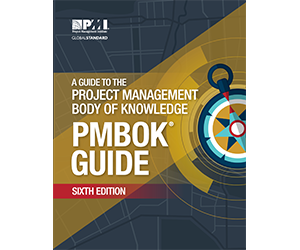
Managing the project resources is how the project manager spends most of their time. From ordering supplies, to training team members, to paying bills, the project resources are a seemingly bottomless pit of active management. Meanwhile, the project team is one of the most important components of project success – Having confidence that your team is going to get the job done right, on time, and under budget, is virtually priceless. This is included in the Project Management Body of Knowledge ( PMBOK ) Project Resource Management knowledge area.
The 6 processes in this knowledge area are:
Plan Resource Management
Estimate activity resources.
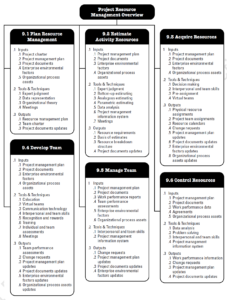
Develop Team
Manage team, control resources.
Before any project can proceed, the project resource requirements need to be defined. The main part of this initial planning step involves identifying the type and quantity of resources that are required, including people. Some resources have a grade or skill level associated with them, such as experience level of people, or size of crane. Job descriptions are created for the project team members. The Project Resource Management Plan, a component of the overall Project Management Plan , summarizes this resource planning step.
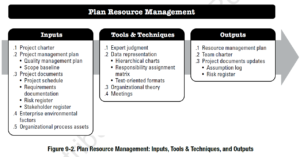
- Quality management plan
- Scope baseline
- Project schedule
- Requirements documentation
- Risk register
- Stakeholder register
- Enterprise environmental factors
- Organizational process assets
Tools & Techniques
- Expert judgment
- Hierarchical charts
- Responsibility assignment matrix
- Text-oriented formats
- Organizational theory
- Resource management plan
- Team charter
- Assumption log
The resources required to carry out the project must almost always be estimated during the planning stage. Resources are classified into type and quantity, as well as other factors that might affect the cost or schedule, such as grade, quality, availability, and so on. The three primary methods of estimating, Analogous, Parametric, and Three point, are used in conjunction with bottom up or top down estimating to determine the resource requirements.
- Activity attributes
- Activity list
- Cost estimates
- Resource calendars
- Bottom-up estimating
- Analogous estimating
- Parametric estimating
- Alternatives analysis
- Project management information system
- Resource requirements
- Basis of estimates
- Resource breakdown structure
- Lessons learned register
Acquire Resources
Once the project execution phase is underway, the resources identified in the Resource Management Plan must be acquired. The project schedule is consulted to determine when the resources are needed. The Procurement Management Plan, a separate component of the Project Management Plan, guides the purchasing process for tools and equipment that must be purchased. Project team positions are advertised and the workers are hired.
- Procurement management plan
- Cost baseline
- Multi-criteria decision analysis
- Negotiation
- Pre-assignment
- Virtual teams
- Physical resource assignments
- Project team assignments
- Change requests
- Enterprise environmental factors updates
- Organizational process assets updates
Most projects require additional knowledge to complete their deliverables. The project team must obtain this knowledge at the appropriate point in the project timeline. Unlike tools and equipment, project team members require rewarding work, future opportunities, and career development, or they will leave.
- Communication technology
- Conflict management
- Influencing
- Team building
- Recognition and rewards
- Individual and team assessments
- Team performance assessments
The project team is one of the most important components of project success (actually, any organization’s success). Project team assignments tend to change as team members learn different project tasks and project managers assess their strengths and weaknesses. Project issues need to be dealt with by the appropriate project team members, and project work needs to be actively managed.
- Work performance reports
- Decision making
- Emotional intelligence
- Schedule baseline
The project resources require regular, ongoing control procedures to ensure they are being used most efficiently, that they are performing the required tasks, and so on. The Resource Management Plan must be consulted regularly to ensure that project resource usage is according to plan. Cost-benefit analysis and alternatives analysis are utilized to optimize the use of resources.
- Work performance information
- Cost-benefit analysis
- Performance reviews
- Trend analysis
- Problem solving
Related posts:
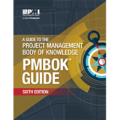
About Bernie Roseke, P.Eng., PMP
Bernie Roseke, P.Eng., PMP, is the president of Roseke Engineering . As a bridge engineer and project manager, he manages projects ranging from small, local bridges to multi-million dollar projects. He is also the technical brains behind ProjectEngineer , the online project management system for engineers. He is a licensed professional engineer, certified project manager, and six sigma black belt. He lives in Lethbridge, Alberta, Canada, with his wife and two kids.
Leave a Reply Cancel reply
Your email address will not be published. Required fields are marked *

- Project Initiation
- Project Planning
- Project Execution
- Monitoring and Controlling
- Project Closure
- Project Management Tutorial
- Project Scheduling Tutorial
- Earned Value Tutorial
- PMP Exam Tutorial
- Find Talent
- PRINCE2 Foundation
- PRINCE2 Practitioner
- PRINCE2 Professional
- IPMA Level A
- IPMA Level B
- IPMA Level C
- IPMA Level D
- Learning Videos
Certification
Recent posts.
- PMI Project Knowledge Areas, Intro
- PMI Project Knowledge Areas, Video 1: Project Integration
- Project Risk Checklist
- Creating a Risk Register
- 50 SMART Goals
- Reporting Earned Value
- Analogous Estimating
- Variance at Completion (Earned Value Analysis)
- TCPI (Earned Value Analysis)
FIND IT HERE
Subscibe to ProjectEngineer.NET channel – YouTube
- WordPress.org
- Documentation
- Support Forums
- 08181031787
- [email protected]
- Resume My Training
- International Learnsmart
Course Information
- Key Skills For Workplace Success
- Beyond Workplace Politics: Using Social and Emotional Competencies
- Intrapreneurship
- Critical Thinking
- Intermediate Project Management
- Developing Your Executive Presence
- Mastering the Interview
- Getting Your Job Search Started
- Creating a Dynamite Job Portfolio
- Fundamentals of Writing
- Getting Stuff Done
- Creativity In The Workplace
- Becoming a Better Learner
- English as a Second Language: A Workplace Communications Primer
- Appreciative Inquiry
- Getting Organized for Peak Performance
- The Minute Taker's Workshop
- Stress Management
- Problem Solving and Decision Making
- Personal Brand - Maximizing Personal Impact
- NLP Tools for Real Life
- Managing Pressure and Maintaining Balance
- Introduction to Neuro Linguistic Programming
- Goal Setting
- Conquering Your Fear of Speaking in Public
- Building Your Self Esteem and Assertiveness Skills
- Anger Management
- Unconscious Bias In The Workplace
- Communication Skills For Technical Professionals
- 10-Minute Presentations
- Delivering Dynamic Virtual Presentations
- Business Writing
- Writing Reports and Proposals
- Being a Team Player
- Honing and Delivering Your Message
- Giving Effective Feedback
- Public Relations Boot Camp
- Emotional Intelligence
- Making Training Stick
- Workplace Harassment: What It Is and What to Do About It
- Research Skills
- Public Speaking
- Speaking Under Pressure
- Managing Difficult Conversations
- Dealing With Difficult People
- Communications for Small Business Owners
- Communication Strategies
- Active Listening
- Project Management: All You Need to Know
- Understanding Project Management
Project Management Fundamentals
- Becoming a Leader with Integrity
- Business Leadership For Managers
- From Boss to Leader
- Women and Leadership: Owning Your Strengths and Skills
- Conversational Leadership
- Coaching and Mentoring
- Self-Leadership
- Managing Across Cultures
- Motivating Your Workforce
- Closing the Generation Gap in the Workplace
- Delegation - The Art of Delegating Effectively
- Change Management
- Progressive Discipline
- Vendor Management
- Leadership Skills for Supervisors: Communication, Coaching, and Conflict
- Making Your Business Better
- Workplace Health and Safety: The Supervisor's Role and Responsibilities
- Creating a Positive Work Environment
- The ABC of Supervising Others
- Strategic Planning
- Business Process Management
- Effective Planning and Scheduling
- Tough Topics: Talking to Employees about Personal Hygiene
- Managing The Virtual Workplace
- The Professional Supervisor
- Developing High Performance Teams
- Risk Management
- Meeting Management - The Art of Making Meetings Work
- Employee Accountability
- Managing Customer Service
- Crisis Management
- Conference and Event Management
- Building Better Teams
- Basic Business Management - Boot Camp for Business Owners
- Creating Winning Proposals
- Writing a Business Plan
- Writing for the Web
- Kickstarting Your Business with Crowdsourcing
- Building a Consulting Business
- Building an Online Business
- Entrepreneurship 101
- Creative Thinking and Innovation
- Fostering Innovation
- Building a Brand on Social Media
- Developing and Maintaining a Succession Plan
- Microsoft PowerPoint For Beginners
- Microsoft PowerPoint: All You Need To Know
- No Course(s) Found!
- Microsoft Excel For Beginners
- Intermediate Microsoft Excel
- Advanced Microsoft Excel
- Microsoft Excel: All You Need to Know
- Creating Winning Webinars: Getting Your Message Out
- Introduction to HTML and CSS Coding
- Introduction to HTML and CSS Coding Part 2
- Social Selling
- Selling Smarter
- Prospecting For Leads
- Dynamite Sales Presentations
- Overcoming Objections to Nail the Sale
- Networking for Success
- Negotiating for Results
- Building Relationships for Success in Sales
- Reading Body Language as a Sales Tool
- Telemarketing
- Email Marketing
- Growth Hacking
- Story Marketing
- Promoting a Marketing Webinar
- Working with the Media: Creating a Positive Working Relationship
- Trade Shows: Getting the Most Out of Your Trade Show Experience
- Influence and Persuasion
- E-Commerce Management
- Conducting Accurate Internet Research
- Marketing with Social Media
- Marketing for Small Businesses
- Marketing and Sales
- Creating a Google AdWords Campaign
- Branding - Creating and Managing Your Corporate Brand
- Basic Internet Marketing
- Advanced Writing Skills
- What Customers Really Want–And How to Deliver It
- Customer Relationship Management
- Business Etiquette - Gaining That Extra Edge
- Handling Customer Complaints
- Customer Service Training
- Design Thinking
- Sales and Customer Service Training for Call Center Agents
- Training with Visual Storytelling
- Measuring Training Results
- Employee Recognition: Appreciating Your Workforce
- Creating a Top-Notch Talent Management Program
- Managing Employee Performance
- Knowledge Management
- HR for the Non-HR Manager
- Developing a Lunch and Learn Program
- Planning for Workplace Safety
- Creating Successful Staff Retreats
- Workplace Ergonomics - Injury Prevention Through Ergonomics
- Using Activities to Make Training Fun
- The Practical Trainer
- Survival Skills for the New Trainer
- Orientation Handbook - Getting Employees Off to a Good Start
- Onboarding: The Essential Rules for a Successful Onboarding Program
- Hiring for Success - Behavioral Interviewing Techniques
- Facilitation Skills
- Developing Your Training Program
- Creating a Workplace Wellness Program
- Conducting Effective Performance Reviews
- Bullying in the Workplace
- Balanced Scorecard Basics
- Advanced Skills for the Practical Trainer
- Conflict Resolution In The Workplace
- Managing Anger and Violence in the Workplace
- Becoming a Progressive Employer: Setting Trends Instead of Following Them
- Budgets and Managing Money
- Accounting Skills for New Supervisors
- Digital Citizenship: Conducting Yourself in a Digital World
- Digital Transformation
- Collaboration
- Continuous Improvement with Lean
- Purchase and Procurement
- Lean Process Improvement
- Process Improvement with Gap Analysis
- Working Smarter: Using Technology to Your Advantage
- Safe Food Handling
- Inventory Management: The Nuts and Bolts
- Skills for the Administrative Assistant
- Online Tools for Small Business
- Project Planning: All You Need to Know
- Logistics and Supply Chain Management
- Advanced Project Management
- Developing a High Reliablity Organization
- Diversity, Equity, and Inclusion
- Respect in the Workplace
- An Environmental Audit Primer
- Environmental Sustainability: A Practical Approach to Greening Your Organization
- Creating a Workplace Code of Conduct
- Celebrating Diversity in the Workplace
- Encouraging Sustainability and Social Responsibility in Business
- Disability Awareness - Working with People with Disabilities
- Business Ethics for the Office
- Cybersecurity: Fundamentals for Employees
- Developing a Safety Procedures Manual
- Global Business Strategies

After completing this course, participants will be able to:
- Understand what is meant by a project
- Understand what project management means
- Identify benefits of projects
- Identify the phases of a project’s life cycle
- Sell ideas and make presentations related to pitching a project
- Prioritize projects
- Begin conceptualizing your project, including goals and vision statements
- Use project planning tools
- Contribute to creating a Statement of Work.
Course Outline
Session 1: Course Overview
- Learning Objectives
- Pre-Assignment
- Pre-Course Assessment
Session 2: Defining Projects and Project Management
- What is a Project?
- Summary
- What is Project Management?
- Process Groups
- Nine Knowledge Areas
- Who Are the Key Players?
- Example
Session 3: The Role of a Project Manager
- Setting Your Sights
- Improvement Proposal Form, Part One
- Improvement Proposal Form, Part Two
- Bringing the Team Together
- Key Skill Areas
Session 4: Pre-Assignment Review
- Pre-Assignment Review
- Planning Questions
- Eight Aspects of a Project
Session 5: How Can Projects Help Me?
- The Benefits of Projects
- Case Study: Mary Marvelous
- Question
Session 6: A Project’s Life Cycle
- The Life Cycle
- Phase One: Conceptual
- Phase Two: Planning
- Phase Three: Execution
- Phase Four: Termination
- Milestones
- Why Do Projects Fail?
- How Can My Project Succeed?
- Three Ways to End a Project
- Stages of a Project
Session 7: Selling a Project
- Advice from Tom Peters
- Gathering Support for Your Idea
- Key Questions
- The Priority Matrix
- The Priority Matrix, Part One
- The Priority Matrix, Part Two
- Priority Quadrants, Part One
- Priority Quadrants, Part Two
Session 8: Creating a Vision
- The Vision Process
- Sample Brainstorming Diagram
- Defining Objectives
- Creating a Vision
- Making Connections
Session 9: Project Goals
- Setting Goals with SPIRIT
- SPIRIT Goals
- Two Additional Criteria
- Your Project's Goals
Session 10: Using a Target Chart
- Creating a Target Chart, Step One
- Creating a Target Chart, Step Two
- Creating a Target Chart, Step Three
- Creating a Target Chart, Step Four
Session 11: Preparing Your Project
- Things to Consider, Part One
Session 12: Laying Out the Project
- The Statement of Work
- Defined Purpose
- Statement of Scope
- Project Deliverables
- Goals and Objectives
- Cost and Schedule Estimates
- List of Stakeholders
- Authority Levels
- Assumptions and Agreements
- The Communication Plan
- Individual SOW
- Project Planning Worksheet
Session 13: A Personal Action Plan
- Starting Point
- Where I Want to Go
- How I Will Get There
- Recommended Reading List
Post-Course Assessment
Training Information
Delivery: E-learning (interactive, self-paced, and convenient).
How It Works: Using the unique login details we will send, participants simply access our learning portal with their browser and start learning.
Each participant will be in control of their learning pace and so can leverage our built-in concept of scaffolding to boost learning outcome.
Besides, they take the training at their convenience – any time of the day that suits their schedule and as frequently as they like until they finish.
Anywhere in the course a participant stops temporarily, it’s automatically saved so when they resume they continue from there by default.
Duration: Because it's self-paced, participants finish at different times. However, on the average, busy participants finish in 1 week.
Reports: We send reports periodically to your organization until all participants complete their training. For each participant, the reports show progress, performance score, total time spent learning, and the last time course was accessed.
Certificate: Each participant receives a certificate of training if course is successfully completed.
Access period: 30 days (can be extended).
Access device: Computer, Smartphone, or Tablet.
Comes with: Course transcripts for reference, and 100% money-back guarantee.
Learning Management & Support: We are usually in touch with every participant to encourage and support them until they finish. This leads to very high course completion rate.
Learning Outcome: On LearnSmart, the learning outcome compares favorably with that of conventional training. This is because of increased level of participation through interactivity and learning-pace control.
Throughout each course, in an interactive manner, there are engaging questions and exercises that help assess the participant’s understanding as they learn. This approach gives concepts their own room to breathe and get digested.
And with control of their learning pace, each participant will have the ability to stop and reflect whenever they want, or return to previously-delivered content, and thus ensure a deeper understanding before continuing. A participant will have the time to digest and integrate information being presented into their existing understanding and context. This is how they make sense of it leading to higher levels of cognitive engagement and higher levels of retention.
For the best learning outcome, we recommend that training be taken in chunks of minutes consistently rather than taking it in a long stretch trying to finish quickly.
How To Enroll
Option 1 (for organizations that want to enroll their employees)
To have employees of your organization enrolled, please send the following to [email protected]:
- Name and email address of each employee and the course they are to take
- Name and email address of the person who will be receiving training reports
Once we receive the above information, we enroll the employees and send each of them an email containing their unique login details and step-by-step guide on how to start training.
Then, we will be sending training reports periodically to your organization on how all the employees are doing. For each employee, the reports show progress, performance score, total time spent learning, and the last time course was accessed.
At the end of the training, if you’re satisfied with our service, we send you an invoice and you pay. If, for any reason, you’re not satisfied with our service, we would not take any payment from you.
Option 2 (for individuals buying this course for themselves)
Click on "Enroll For This Course”, checkout and make payment with your Visa, Master, or Amex card. You will receive your unique login details by email and start training.

Leadership & Management

Project Management
Understanding Project Management
- Description
- Additional Information

Project management isn’t just for construction engineers and military logistics experts anymore. Today, in addition to regular job duties, people are often expected to take on extra assignments and to get that additional job done well, done under budget, and done on time.
This course is not intended to take participants from a supervisory or administrative position to that of a project manager. However, these three days will familiarize them with the most common terms and the most current thinking about projects. In this, you will walk participants through the nuts and bolts of project management, from setting priorities to controlling expenses and reporting on the results. They may still have to cope with the unexpected, but they’ll be better prepared.
Objectives
- Understand what is meant by a project.
- Recognize what steps must be taken to complete projects on time and on budget.
- Sell ideas and make presentations.
- Use simple techniques and tools for planning and tracking a project.
- Use methods for keeping the team focused and motivated.
Course Content
- Session One: Course Overview
- Session Two: What is a Project?
- Session Three: Project Management Basics
- Session Four: Pre-Assignment Review
- Session Five: How Can Projects Help Me?
- Session Six: A Project’s Life Cycle
- Session Seven: Selling a Project
- Session Eight: Preparing Your Project
- Session Nine: The Role of a Project Manager
- Session Ten: Project Goals
- Session Eleven: Laying Out the Project
- Session Twelve: Project Risks
- Session Thirteen: Contingency Planning
- Session Fourteen: What Really Needs To Be Done?
- Session Fifteen: The Work Breakdown Structure
- Session Sixteen: Planning Tools
- Session Seventeen: Budgets
- Session Eighteen: Teamwork
- Session Nineteen: Developing Teams
- Session Twenty: Putting it Into Practice
- Session Twenty-One: Communication Tips
- Session Twenty-Two: Closing Out a Project
- Session Twenty-Three: Team Meetings
- Session Twenty-Four: Presentation Primer
- Session Twenty-Five: Project Presentations
Certificate
A participation certificate will be issued upon completion of the course.

Similar Items
You may also like.
$22.00 Team Building Through Chemistry Team Building Through Chemistry Team Building Find out more Add to Cart
$27.00 Servant Leadership Servant Leadership With this course, you will discover the specifics of servant leadersh… Find out more Add to Cart
$27.00 Organizational Skills Organizational Skills Good organizational skills can prove beneficial in many areas of life. Find out more Add to Cart
We use essential cookies to make Venngage work. By clicking “Accept All Cookies”, you agree to the storing of cookies on your device to enhance site navigation, analyze site usage, and assist in our marketing efforts.
Manage Cookies
Cookies and similar technologies collect certain information about how you’re using our website. Some of them are essential, and without them you wouldn’t be able to use Venngage. But others are optional, and you get to choose whether we use them or not.
Strictly Necessary Cookies
These cookies are always on, as they’re essential for making Venngage work, and making it safe. Without these cookies, services you’ve asked for can’t be provided.
Show cookie providers
- Google Login
Functionality Cookies
These cookies help us provide enhanced functionality and personalisation, and remember your settings. They may be set by us or by third party providers.
Performance Cookies
These cookies help us analyze how many people are using Venngage, where they come from and how they're using it. If you opt out of these cookies, we can’t get feedback to make Venngage better for you and all our users.
- Google Analytics
Targeting Cookies
These cookies are set by our advertising partners to track your activity and show you relevant Venngage ads on other sites as you browse the internet.
- Google Tag Manager
- Infographics
- Daily Infographics
- Graphic Design
- Graphs and Charts
- Data Visualization
- Human Resources
- Beginner Guides
Blog Marketing
What is a Project Management Plan and How to Create One
By Midori Nediger , Dec 11, 2023

Have you ever been part of a project that didn’t go as planned?
It doesn’t feel good.
Wasted time, wasted resources. It’s pretty frustrating for everyone involved.
That’s why it’s so important to create a comprehensive project management plan before your project gets off the ground.
In this guide, we’ll explore how to create and design a successful project management plan.
We’ll also showcase easy-to-customize project plan templates you can create today with our user-friendly drag-and-drop editor. Let’s get started!
Click to jump ahead:
What is a project management plan?
5 things you need to know before creating a project management plan, what should a project management plan include, how do you write a project plan, project plan best practices, project management plan templates and examples, common mistakes to avoid when creating a project management plan.
A project management plan is a formal document that defines how a project is going to be carried out by outlining the scope, goals, budget, timeline and deliverables of a project. Its crucial role lies in ensuring the project stays on course.
You write a project plan during the project planning stage of the project life cycle , and it must be approved by stakeholders before a project can move on the execution stage.
If some of these terms are new to you, you can get up to speed with this post on project management terms .
This means your project plan must be engaging, organized, and thorough enough to gain the support of your stakeholders.

Further Reading : New to project management? Read our blog post on the 4 stages of the project life cycle .
The importance of a project management plan
A well-developed project management plan sets the foundation for a successful project by providing a roadmap that guides the project team toward successful project completion. A good project management plan can ensure that:
- Project objectives and goals are clearly defined and understood
- Project scope is effectively managed
- Resources are allocated efficiently to maximize productivity and minimize waste
- Risks are identified, assessed and mitigated
- Project tasks and activities are well-organized and executed in a timely manner.
- Communication among team members , stakeholders and project sponsors is effective and transparent
- Changes to the project are properly evaluated, approved and implemented
- Lessons learned and best practices are documented for future reference and improvement
- Stakeholders are engaged and satisfied with the project outcomes
- The project is delivered within the specified timeline, budget and quality standards
Before diving into creating a project management plan, it is crucial to have a clear understanding of the project objectives and the expectations of stakeholders involved.
Without a firm grasp of these fundamental elements, your project may face significant challenges or fail to deliver the desired outcomes.
Here are key points to consider when creating a project management plan:
- Project Objectives: Clearly understand the project objectives and what you want to achieve. Identify the desired outcomes, deliverables and the purpose of the project.
- Scope of the Project: Determine the boundaries and extent of the project. Define what is included and excluded to ensure clarity and prevent scope creep .
- Stakeholders: Identify all stakeholders who will be impacted by or have an interest in the project. Understand their needs, expectations and level of involvement.
- Resources: Assess the resources required to execute the project successfully. This includes human resources, budget, equipment and materials. Determine their availability and allocation.
- Risks and Constraints: Identify potential risks, uncertainties and constraints that may affect the project. Understand the challenges, limitations and potential obstacles that need to be addressed.
Now that you have these key areas identified, let’s get started with creating your project plan.
Before you start assembling your own plan, you should be familiar with the main components of a typical project plan .
A project management plan should include the following sections:
- Executive summary: A short description of the contents of the report
- Project scope & deliverables: An outline of the boundaries of the project, and a description of how the project will be broken down into measurable deliverables
- Project schedule: A high-level view of project tasks and milestones ( Gantt charts are handy for this)
- Project resources: The budget, personnel, and other resources required to meet project goals
- Risk and issue management plan: A list of factors that could derail the project and a plan for how issues will be identified, addressed, and controlled
- Communication management plan: A plan for how team and stakeholder communication will be handled over the course of the project
- Cost and quality management plan: This section encompasses the project’s budget, cost estimation,and cost control mechanisms. It also includes quality assurance and control measures as well as any testing or verification activities to be performed.
Basically, a project plan should tell stakeholders what needs to get done, how it will get done, and when it will get done.
That said, one size doesn’t fit all. Every project management plan must be tailored to the specific industry and circumstances of the project. You can use a project management app for smoother project planning.
For example, this marketing plan looks client facing. It is tailored to sell the client on the agency:

Whereas this commercial development plan focuses on specific objectives and a detailed timeline:

With those basics out of the way, let’s get into how to write a project management plan that’s as engaging as it is professional.
Further Reading : If you’re looking to create a proposal, read our in-depth business proposal guide. Then try our job proposal templates or business proposal templates .
To write a successful project plan, follow these 5 steps below to create an effective project plan that serves as a valuable tool for project management:
1. Highlight the key elements of your project plan in an executive summary
An executive summary is a brief description of the key contents of a project plan .
I t’s usually the first thing stakeholders will read, and it should act like a Cliff’s-notes version of the whole plan.
It might touch on a project’s value proposition, goals, deliverables, and important milestones, but it has to be concise (it is a summary, after all). First, make sure you develop a proof of concept .
In this example, an executive summary can be broken into columns to contrast the existing problem with the project solution:

The two-column format with clear headers helps break up the information, making it extremely easy to read at a glance.
Here’s another example of a project management plan executive summary. This one visually highlights key takeaways with big fonts and helpful icons:

In this case, the highlighted facts and figures are particularly easy to scan (which is sure to make your stakeholders happy).
But your executive summary won’t always be so simple.
For larger projects, your executive summary will be longer and more detailed.
This project management plan template has a text-heavy executive summary, though the bold headers and different background colors keep it from looking overwhelming:

It’s also a good idea to divide it up into sections, with a dedicated header for each section:

Regardless of how you organize your executive summary, it should give your stakeholders a preview of what’s to come in the rest of the project management plan.
2. Plot your project schedule visually with a Gantt chart
A carefully planned project schedule is key to the success of any project. Without one, your project will likely crumble into a mess of missed deadlines, poor team management, and scope creep.
Luckily, project planning tools like Gantt charts and project timelines make creating your project schedule easy. You can visually plot each project task, add major milestones, then look for any dependencies or conflicts that you haven’t accounted for.
For example, this Gantt chart template outlines high-level project activities over the course of an entire quarter, with tasks color-coded by team:

A high-level roadmap like the one above is probably sufficient for your project management plan. Every team will be able to refer back to this timeline throughout the project to make sure they’re on track.
But before project kickoff, you’ll need to dig in and break down project responsibilities by individual team member, like in this Gantt chart example:
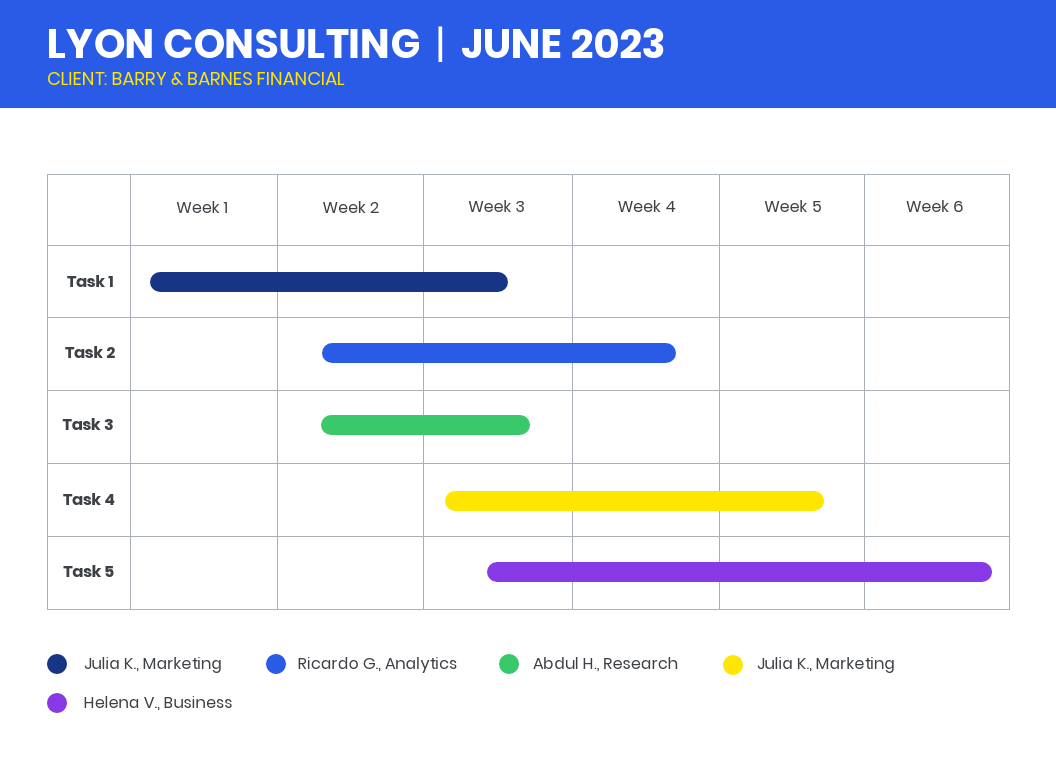
In the later execution and monitoring phases of the project, you’ll thank yourself for creating a detailed visual roadmap that you can track and adjust as things change.
You can also use a project management tool to keep your team organized.
Further Reading: Our post featuring Gantt chart examples and more tips on how to use them for project management.
3. Clarify the structure of your project team with a team org chart
One of the hardest aspects of project planning is assembling a team and aligning them to the project vision.
And aligning your team is all about communication–communicating the project goals, communicating stakeholder requests, communicating the rationale behind big decisions…the list goes on.
This is where good project documentation is crucial! You need to create documents that your team and your stakeholders can access when they have questions or need guidance.
One easy thing to document visually is the structure of your team, with an organizational chart like this one:

In an organizational chart you should include some basic information like team hierarchy and team member contact information. That way your stakeholders have all of the information they need at their fingertips.
But in addition to that, you can indicate the high-level responsibilities of each team member and the channels of communication within the team (so your team knows exactly what they’re accountable for).
Here’s another simple organizational structure template that you can use as a starting point:

Create an organizational chart with our organizational chart maker .
4. Organize project risk factors in a risk breakdown structure
A big part of project planning is identifying the factors that are likely to derail your project, and coming up with plans and process to deal with those factors. This is generally referred to as risk management .
The first step in coming up with a risk management plan is to list all of the factors at play, which is where a risk breakdown structure comes in handy. A risk breakdown structure is a hierarchical representation of project risks, organized by category.
This risk breakdown structure template, for example, shows project risk broken down into technical risk, management risk, and external risk:

Once you’ve constructed your risk breakdown structure, you’ll be ready to do a deep dive into each risk (to assess and plan for any triggers and outcomes).
Streamline your workflow with business process management software .
5. Plan ahead: create project status reports to communicate progress to stakeholders
As I mentioned earlier, communication is fundamental in any project.
But even so, something that’s often overlooked by project managers is a communication management plan–a plan for how the project team is going to communicate with project stakeholders . Too often, project communication defaults to ad-hoc emails or last-minute meetings.
You can avoid this by planning ahead. Start with a project kickoff meeting and include a project status report template as part of your communication plan.
Here’s an example of a simple project status report that you might send to stakeholders on a weekly basis:

This type of report is invaluable for communicating updates on project progress. It shows what you’ve accomplished in a clear, consistent format, which can help flag issues before they arise, build trust with your stakeholders , and makes it easy to reflect on project performance once you’ve reached your goals.
You might also want to include a broader status report for bigger updates on a monthly or quarterly basis, like this one:

The above template allows you to inform stakeholders of more major updates like new budget requirements, revised completion dates, and project performance ratings.
You can even include visualization of up-to-date project milestones, like this example below:

Want more tips on creating visuals to enhance your communications? Read our visual communication guide for businesses .
Before you dive in, remember: a clear and adaptable plan is crucial for project success. Here are some best practices to keep your project plan on track:
- Use headers, columns and highlights to make your executive summary easy to read
- Plot your project schedule with a Gantt chart (with tasks color-coded by department or team member)
- Use visuals like organizational charts and risk breakdown structures to communicate across your team and with stakeholders
- Pick a flexible template that you can update to align with stakeholder requests
A project management plan is probably the most important deliverable your stakeholders will receive from you (besides the project itself).
It holds all of the information that stakeholders will use to determine whether your project moves forward or gets kicked to the curb.
That’s why it’s a good idea to start with a project management plan template. Using a template can help you organize your information logically and ensure it’s engaging enough to hold your stakeholders’ attention.
Construction project management plan template
Time is money, especially with construction projects. Having a construction plan template brings order to the chaos.
Instead of staring at a messy pile of construction stuff, you’ve got a plan that breaks everything down into bite-sized pieces.
And let’s not forget the paperwork. Construction projects have rules and regulations to follow. Your project plan helps you stay on the right side of the law with all the necessary documentation and compliance measures.
Start with a meticulous project overview, like in the second page of this template:

Though you may think this project will be similar to others you’ve done in the past, it’s important to nail the details.
This will also help you understand the scope of work so you can estimate costs properly and arrive at a quote that’s neither too high or low. Ontario Construction News has great advice on this process.
Simple project management plan template
This simple project management plan template that clearly lays out all of the information your stakeholders will need:
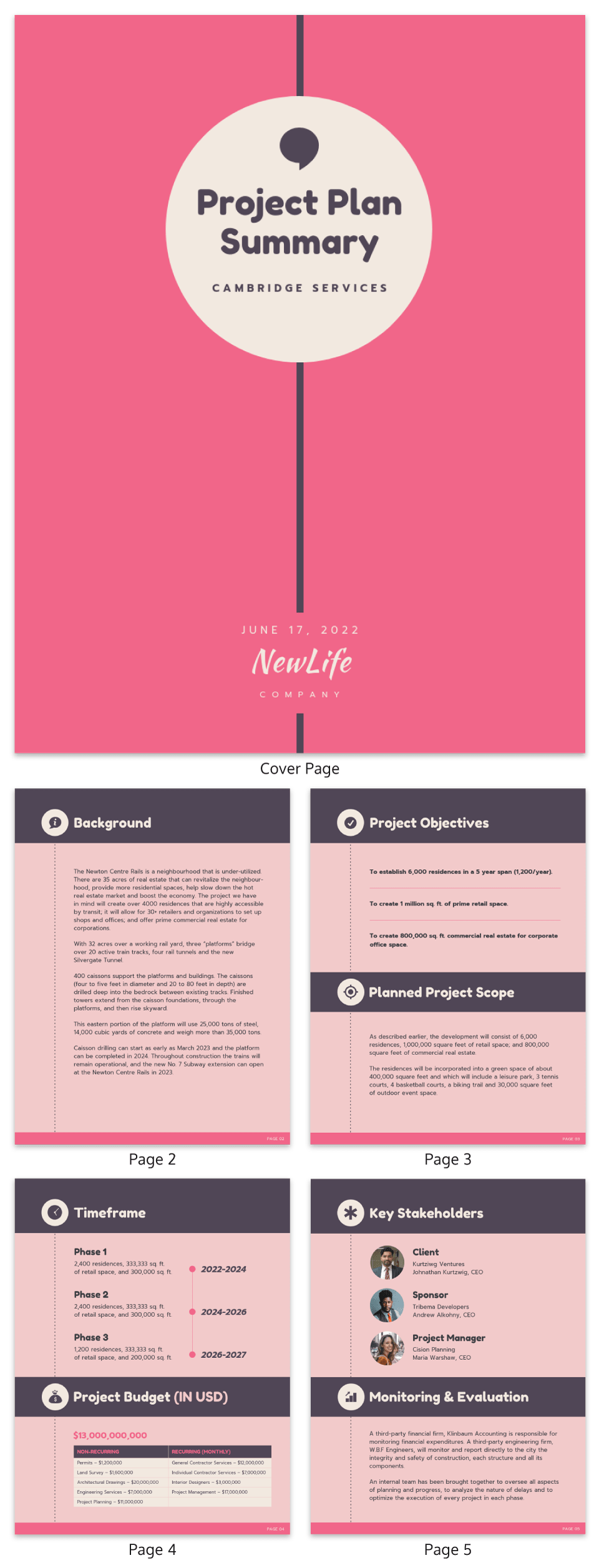
Simple project management communication plan template
A key part of project management is making sure everyone’s in the loop. A project communication plan ensures everyone knows how, where, who and when the team will communicate during the course of the project. Also construction scheduling is a critical aspect of the project management plan as it helps to ensure that all necessary tasks are completed within the allocated time frame and budget.
The key is to figure out what kind of communications is valuable to stakeholders and what is simply overwhelming and won’t lead to better decisions.
This template clearly outlines all of these factors to help manage expectations and eliminate confusion about what will get communicated and when:

Commercial development project plan template
The below project management plan template is simple and minimal, but still uses a unique layout and simple visuals to create an easy-to-read, scannable project overview.
This template is perfect for building or construction management , or any technical projects:

When picking a project plan template, look for one that’s flexible enough to accommodate any changes your stakeholders might request before they’ll approve the project. You never know what might change in the early planning stages of the project! You can also use project management tools to help you with your planning !
Creating a solid project management plan is crucial for setting your project up for success. Here are some common mistakes to avoid:
- Lack of clear goals: Don’t just have a vague idea of what you want to achieve. Define clear, SMART goals (Specific, Measurable, Achievable, Relevant and Time-bound) for your project. That way, everyone will be on the same page and it’ll be easier to measure progress effectively.
- Unrealistic timelines: Be optimistic, but also realistic. Don’t underestimate the time required for tasks. Factor in potential delays and buffer time when creating your project schedule.
- Scope creep: New requirements mid-project can affect deadlines and budgets. Plan the project clearly upfront, and take into consideration any changes that might come up.
- Poor communication: Communication is key throughout the project lifecycle. Regularly update stakeholders, team members and clients on progress, roadblocks and changes.
- Ignoring risks: Things don’t always go according to plan. Identify potential risks upfront and have a mitigation strategy in place for each one.
- Not involving stakeholders: Get key stakeholders involved early on. This helps manage everyone’s expectations and that you have the buy-in you need for success.
- Neglecting resource constraints: Don’t overload your team or underestimate the resources needed. Carefully consider the skills, time and budget available when planning your project.
- Micromanaging: Trust your team! Delegate tasks effectively and give them the autonomy they need to do their jobs.
- Failing to document: Keep good records. Document project decisions, plans and communication. This helps maintain transparency and ensures everyone has access to the latest information.
- Not adapting to change: Be prepared to adapt your plan as needed. Projects are rarely static, so be flexible and willing to adjust your approach based on new information or developments.
So, that’s the scoop on project management plans! I hope this piece will help you to avoid confusion, keep expectations in check and be ready to tackle any bumps for your upcoming projects.
If you ever need a revision, just follow the steps we talked about, use those best practices and you’ll have a plan that sets your project up for a win. Just remember, even the best plans need some tweaking sometimes. Be flexible and adjust as needed and you’re good to go!
- Recent Topics
- Forum Policy
TOPIC: Is pre-assignment a project constraint?
Is pre-assignment a project constraint 11 years 1 month ago #3162, is pre-assignment a project constraint 11 years 1 month ago #3163, is pre-assignment a project constraint 11 years 1 month ago #3164, is pre-assignment a project constraint 11 years 1 month ago #3166.
- Our Mission
- Our Partners
- Terms & Conditions
- Privacy Notice
- Corporate Project Management Training
- Group Discounts
- PM PrepCast Discount Coupon
- Scholarships
- Free PMP® Newsletter
- Free PMP® Questions
- Free PMI-ACP® Questions
- Free CAPM® Simulator
- Project Management Basics
- Mastering Business Analysis
- PMP® Exam Simulator
- PMP® Formulas
- PMI-ACP® Exam Training
- CAPM® Exam Training
- PMP® Exam Prep
- PrepCast PMP® Practice Exam
- Forgot your password?
- Forgot your username?
- Order The PM PrepCast
- PM PrepCast Product Details
- PMP Exam Agile Booster Course
- The PMP® Exam Simulator
- The PM Formulas
- The PM StudyCoach (recorded)
- The PM StudyCoach Guidebook
- The PM FlashCards
- All PMP® Products Overview
- PM Basics Course
- Corporate PMP Training
- Order the Agile PrepCast
- Agile PrepCast Product Details
- The ACP StudyCoach Guidebooks
- The PMI-ACP® Exam Simulator
- Corporate PMI-ACP Training
- Order The PM PrepCast for CAPM
- The PM PrepCast for CAPM®
- The CAPM® Exam Simulator
- 60 PMP PDUs - From The PM PrepCast
- 60 PMP PDUs - From The PDU Podcast
- 15 PMP Power Skills PDUs
- 17 PMP Leadership PDUs
- 30 PMI-ACP PDUs
- 17 PMI-ACP Leadership PDUs
- 15 CAPM PDUs
- 5 PDUs Business Analysis Course
- Artificial Intelligence for Project Managers
- Free PM PrepCast Training
- Free PM PrepCast Exam Simulator
- Free PMP® Practice Exam
- The Free PM PrepCast
- Free PMP® Exam Guides
- Free PMP® Exam Newsletter
- Free PMP® Webinars
- All Free PMP® Exam Resources...
- The Free Agile PrepCast
- Free PMI-ACP® Exam Newsletter
- All Free PMI-ACP® Exam Resources...
- Free CAPM® Exam Newsletter
- All Free PDU Resources...
- Explore Corporate Training Offers
- Unlocking Corporate Efficiency
- How PM Training Transform Businesses
- PM Training for Shifting Market Demands
- PM Training for Your Business
- Student Success with PMP Simulation
- PMP® Study Guide
- PMP® Certification Cost
- 35 Hours of Project Management Education
- Knowledge Areas & Process Groups
- How to Fill in the PMP Application
- PMP® Certification Exam
- How to get PMP Certification
- PMP® Exam Questions
- PMP® Certification Bangalore
- Failed PMP Exam
- PMI-ACP Certification Study Guide
- CAPM Certification Study Guide
- 12 Project Management Principles Explained by Experts
- Project Management Certifications Career Advancement
- PMP vs Certifications
- Project Management Organization Company Benefits
- Project Management Organizations Importance
- PM PrepCast Reviews
- PM PrepCast Reviews on Google
- PM Exam Simulator Reviews
- Agile PrepCast Reviews
- PMP® Exam Coaching Reviews
- Exam Prep Essentials eBook Reviews
- Add Your Review
- Student Profiles
- Successful Students
- PMP® Exam Discussion
- PMP® Exam Lessons Learned
- Free PMP® Exam Questions
- PMI-ACP® Exam Discussion
- PMI-ACP® Exam Lessons Learned
- CAPM® Exam Discussion
- CAPM® Exam Lessons Learned
- PDU Questions and Answers
- CIPP/E® Exam Discussion
- CIPP/E® Exam Lessons Learned

IMAGES
VIDEO
COMMENTS
Projects will coordinate resource usage by monitoring the status of shared resources. During a certain project phase, specific blueprints are drawn and approved, materials and labor costs are estimated, prototypes are created, and work activities and tasks are identified. Also, quality expectations, measurements, and costs are defined.
In project management, ensuring the right resources are in place from the outset can be a critical determinant of success. One technique that stands out in this context is pre-assignment. Here's a deeper dive into the concept and its significance. Understanding Pre-assignment Pre-assignment is essentially earmarking specific individuals for roles in a project even before the project
Pre-assignment of project team members can occur for a few reasons. Sometimes specific people are identified in an agreement with a customer or partner. Another reason for pre-assignment is to plan human resource management for the future or over multiple projects or activities. This is most likely when someone has skills or knowledge that are rare or in high demand. Some organization require ...
Section 9.2.2 Acquire Project Team: Tools and Techniques. .1 Pre-Assignment. In some cases, project team members are known in advance; that is, they are preassigned. This situation can occur if the project is the result of specific people being promised as part of a competitive proposal, if the project is dependent on the expertise of ...
PRE-ASSIGNMENT - PMP Tools and Techniques. By Kailash Behera, ... Kailash B is a project management expert. He is passionate about helping people to excel in project and product management, become PMP certified, and progress in their management careers. Post navigation.
If so, influence the people you know and make your case. Ask your connections to influence the decision makers. Acquire outside resources. When your organization lacks staff to complete the required project activities, see if you can acquire outside resources. Here is one reason that project managers need to be involved in projects early.
Pre-Assignment Specific people may be promised as part of a competitive proposal, if the project is dependent on expertise of particular persons. Some staff assignments are defined within the Project ... names inserted into other parts of project management plan (such as organization charts & schedules) Resource Calendars
One of the most effective ways to ensure that projects achieve the outcomes stakeholders expect is to use proven project management techniques when planning projects. This article examines pre-project planning for large projects. In doing so, it lists two reasons for integrating planning into pre-project activities and describes the significance of using a project implementation plan (PIP) to ...
The process is managed by the project management team. The project manager is a person who has an authority to manage the recruiting process and decide on team members. ... Method of pre-assignments allows selecting team members in advanced, before project starts. The method is used in situations when implementation of project depends on the ...
Definition of Pre-Assignment. Team members selected in advance are considered pre-assigned. Sometimes, pre-assigned resources are listed in the project charter itself. Last updated: March 19, 2024.
While every project is different, there are a few general things to do in the pre-planning stage: 1. Plan the scope of your work and set SMART goals. First things first, set goals for your project. Provide as much detail as possible when setting them, and list all the tasks and responsibilities that you want the project team to shoulder.
1. Project Staff Assignment (Using all the inputs and tools and technique staff members are assigned to the project activities) 2. Resource Calendar: documents the time periods each project team member can work on the project. 3. Project Management Plan Updates (Human resource management plan gets updated) Develop Project Team
.1 Project management plan .2 Enterprise environmental factors .3 Organizational process assets.1 Pre-assignment .2 Negotiation .3 Acquisition .4 Virtual teams. Outputs.1 Project staff assignments .2 Resource calendars .3 Project management plan updates. Figure 9-7. Acquire Project Team: Inputs, Tools & Techniques, and Outputs. Figure 9-7.
A project plan houses all the necessary details of your project, such as goals, tasks, scope, deadlines, and deliverables. This shows stakeholders a clear roadmap of your project, ensures you have the resources for it, and holds everyone accountable from the start. In this article, we teach you the seven steps to create your own project plan.
Here's how to approach this first phase of project management and lay a solid foundation for your new project. 1. Create a project charter or business case. In this first step, you demonstrate why your project is necessary and what benefit it will bring. You can do this with either a project charter or a business case.
5. Monitor and adjust the project roles. Be the first to add your personal experience. 6. Improve your project role assignment process. Be the first to add your personal experience. 7. Here's ...
The project resources require regular, ongoing control procedures to ensure they are being used most efficiently, that they are performing the required tasks, and so on. The Resource Management Plan must be consulted regularly to ensure that project resource usage is according to plan. Cost-benefit analysis and alternatives analysis are ...
Understand what project management means. Identify benefits of projects. Identify the phases of a project's life cycle. Sell ideas and make presentations related to pitching a project. Prioritize projects. Begin conceptualizing your project, including goals and vision statements. Use project planning tools. Contribute to creating a Statement ...
Add to wishlist. Buy Course. $22.00. Description. Additional Information. Project management isn't just for construction engineers and military logistics experts anymore. Today, in addition to regular job duties, people are often expected to take on extra assignments and to get that additional job done well, done under budget, and done on time.
To write a successful project plan, follow these 5 steps below to create an effective project plan that serves as a valuable tool for project management: 1. Highlight the key elements of your project plan in an executive summary. An executive summary is a brief description of the key contents of a project plan.
Project Staff Assignments Project is staffed when appropriate people are assigned to work on it Documentation can include a project team directory, memos to team members, and names inserted into other parts of project management plan (such as organization charts & schedules) Resource Calendars
A project constraint is anything that imposes any sort of a limitation on the project. Pre-assignments pre-commit all or some of the resources to the project. This limits the project manager's options and resourcing decisions. Now let's come to the virtual teams. If the term "virtual team" is written as is for the choice.
PRE-ASSESSMENT - PROJECT MANAGEMENT (PHEO) Attempt # Status: Passed. A rm begins its strategic business initiative of developing a new business model that will allow the rm to deliver an efcient, tailored service to its customers. To accomplish this, the rm initiates a business management project.